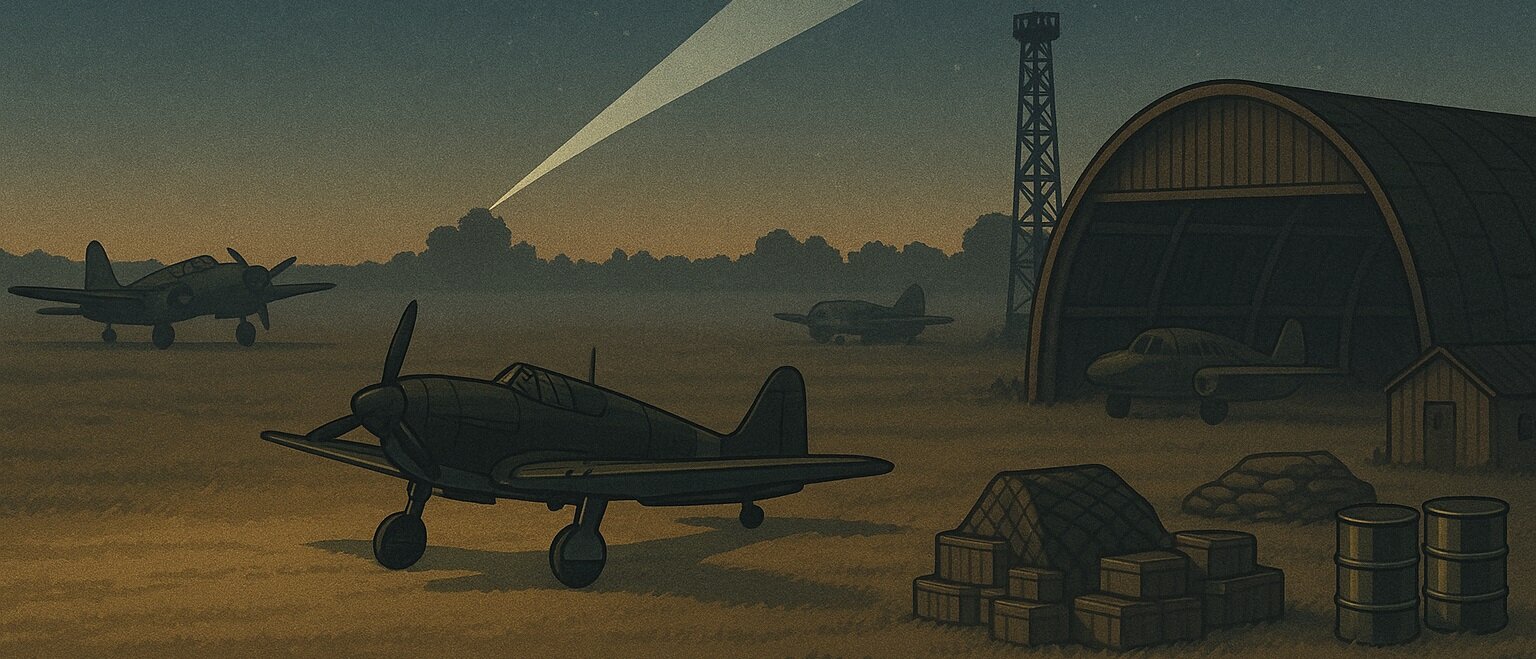On our "FRONT LINE" server for the game "IL-2 Sturmovik," airfields play a much more significant role than simply being a place to start or end a flight. They are transformed into fully-fledged strategic hubs that impact the effectiveness of the entire war effort. Through interaction with these airfields, players do more than just fly - they become part of a complex logistical and economic network.
What are active airfields?
Active airfields are the points on the map from which combat and transport aircraft can take off. Takeoff is only permitted from designated spots, marked by a bonfire at the end of the runway, landing searchlights, or a landing "T". This is a safety measure: a takeoff run in the wrong direction can lead to collisions, damage, or other emergencies.
A pair of I-16s takes off
Airfield Air Defenses.
Each airfield in the game has its own air defense system, including long- and short-range anti-aircraft guns, searchlight crews, and landing light systems. Naturally, the larger the airfield, the more defensive structures it has, making it more resilient to enemy attacks.
No airfield is an easy target. It is crucial to consider the size of the airfield when planning an attack and to gather a sufficient number of experienced pilots. A lack of pilots in the group, combined with powerful enemy AA, can prevent you from accomplishing your mission.
Calculation of air defense at the airfield
Airfield Resources.
All airfields have a maximum resource storage capacity. All resources are consumed to some extent when taking off from an airfield. This means that when a player selects an aircraft and spawns at an airfield, they draw a portion of its resources. The exact amount depends on the aircraft's dry weight, the selected amount of fuel, and the ammunition loadout. You can see the specific resource cost of an aircraft in the game-set.
Airfield resources are displayed on the interactive map and are measured in kilograms. By clicking on an airfield icon on the interactive map, you will see its resource status and other information. The resource quantities update in real-time without needing to reload the page.

Displaying information about the airfield on an interactive map
Display of airfield information on the interactive map:
Fuel - Petroleum, Oil, and Lubricants, represented by a black status bar.
Ammo - Ammunition (bullets, bombs, rockets), represented by a red status bar.
Prov. - Provisions (aircraft, upgrades, engines), represented by a blue status bar.
Actual - The current amount of a resource at the airfield.
Max. - The maximum amount of a resource the airfield can hold.
H - The airfield's altitude above sea level.
Returning Resources to an Airfield.
When a pilot returns to an airfield, they also return the resources on board their aircraft, minus some deductions.
Fuel is calculated based on the average per-minute consumption rate of each specific aircraft type and depends on the initial amount and the flight duration.
Ammunition is calculated and returned based on its actual expenditure during the sortie. Every bomb, rocket, bullet, and shell has its own weight and is accounted for!
Provisions are returned based on the flight duration and the damage the player's aircraft sustained during the sortie.
If an airfield has insufficient resources, the player is notified in the in-game chat (in two languages) upon spawning, and a takeoff restriction is imposed. If this notification is ignored and the player takes off, they will be forcibly kicked from the server. In this case, no resources are deducted from the airfield.
Each airfield consists of taxiways, a runway, and various types of airfield structures. Each structure holds one of the resources listed below:
N – amount of Provisions (Spare parts, consumables, maintenance tools, and the aircraft themselves);
N – amount of Fuel (POL - Petroleum, Oil, and Lubricants);
N – amount of Ammunition (Bombs, rockets, bullets, shells);
The total capacity of an airfield is calculated based on the capacity and number of its structures. The larger the airfield, the more resources it can hold.
Damaged Il-2 after combat flight
Attacking Airfields.
Airfields can (and should) be attacked and disabled to hinder the enemy's ability to counter your plans. Each airfield structure is destroyed along with the resources it contains. By destroying barrels, camouflaged jerrycans, and metal tanks, you will deplete the airfield's fuel based on the capacity of the destroyed structure. By destroying hangars, utility buildings, revetments, and the aircraft within them, you will eliminate provisions. Attacking ammunition stacks under awnings or camouflage nets will destroy ammunition.
Restoration and Resupply of Airfields.
Since damage to airfield structures carries over between missions (with the exception of AA defenses, which are reset each mission), airfields require repair and replenishment. The FRONT LINE server features three mechanics for this:
Supply by transport convoys, etc. (ground vehicles).
Supply by transport aircraft.
Supply by non-transport aircraft (Replenishment only. Repair of damage is not possible!).
Supplying Airfields with Transport Convoys.
Each mission, if one or more airfields require supplies, the mission generator selects a maximum of two of the most needed airfields per side and assigns supply convoys to them (taking resources from the nearest factory). At the end of the mission, the commander analyzes these convoys for their remaining resources. If the convoy still contains resources, the restoration and replenishment process begins as follows:
First, each resource is split in half. One half is allocated for repairing damage.
Repairing each structure requires 50% of its capacity in resources. The system goes through each destroyed structure and repairs it until the repair resources run out or all structures are restored.
If the half of the resource allocated for repairs is fully used, the second half is simply unloaded into the available storage of the airfield's structures, thus replenishing it.
If there is no damage to repair and there are still resources left in the repair half, they are combined with the replenishment half, and the airfield is replenished.
If the airfield is already at its maximum resource capacity and not all supply resources have been used, the remainder is sent directly back to the factory from which it was taken at the start of the mission.
Supplying Airfields with Transport and Non-Transport Aircraft.
Since pilots take resources from an airfield with them on a flight, these resources can easily be transferred to another airfield (even an enemy one, if the enemy and its AA defenses permit) with the deductions described earlier. However, you must always be mindful of the airfield's maximum storage capacity. If a player lands an aircraft at an airfield that is completely full of resources, those resources will be lost. There is simply nowhere to store them.
Supply by transport aircraft works in the same way as supply by ground convoys and trains, with the key difference being that only the resources carried as cargo contribute to the repair and replenishment of the airfield. The aircraft itself, if you exit at the supplied airfield, can only replenish resources (fuel, provisions, and ammunition) as if it were a standard resource transfer from one airfield to another.
Given that airfields are captured along with their remaining resources, this mechanic is useful for an "airfield evacuation" when a side is about to lose an airfield at the end of a mission. This can prevent the enemy from immediately operating from their newly acquired airfield until it is resupplied.
Read about airfield supplies:
Why It's Important to Land Your Aircraft Before the Mission Ends.
If you fail to land your aircraft at an airfield before the mission ends, all resources on board are considered lost. This is especially critical if you flew a heavy aircraft with a large payload of rockets and bombs. The loss of such resources can weaken the defense or offense of your entire team.
The game rewards attentive and disciplined pilots who return their aircraft to base. At the end of a sortie, the in-game chat will report how many and what kind of resources were returned, allowing you to track each player's effectiveness not just by targets destroyed, but also by their contribution to the overall logistics.
Conclusion
On the FRONT LINE server, an airfield is not just a starting point. It is a living part of the strategic game—a logistics center, an economic hub, and a combat asset. Skillful interaction with this mechanic unlocks a whole new level of immersion and team play.
Understanding how airfields work, what affects their efficiency, and how to optimize your sorties turns a regular player into a true commander whose actions can change the course of the entire campaign.






Create an account or sign in to leave a review